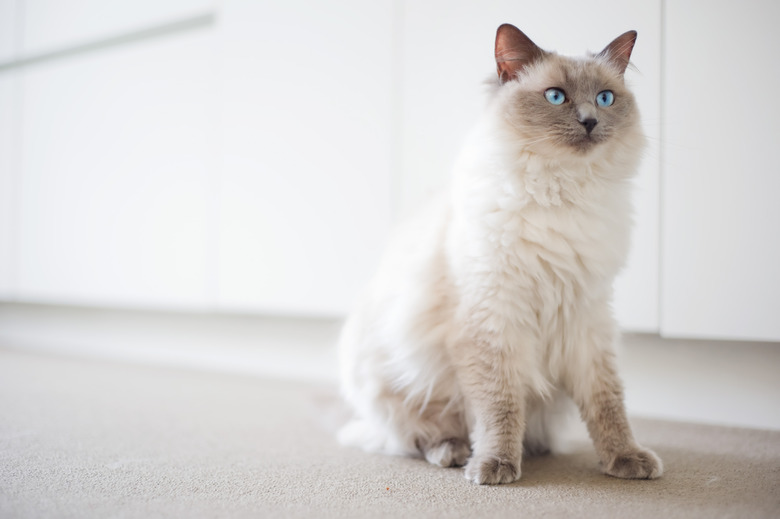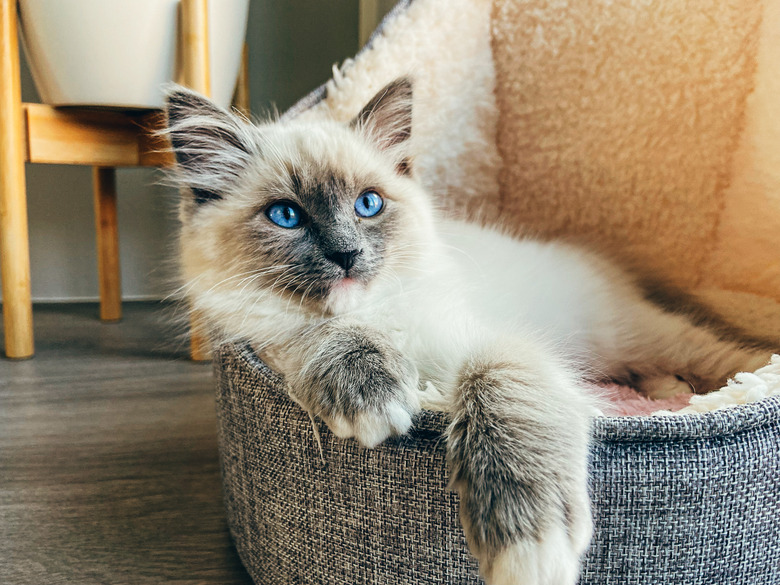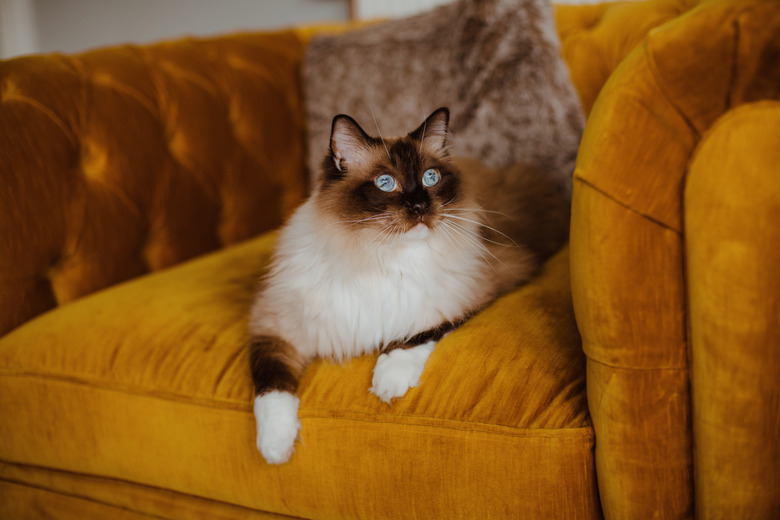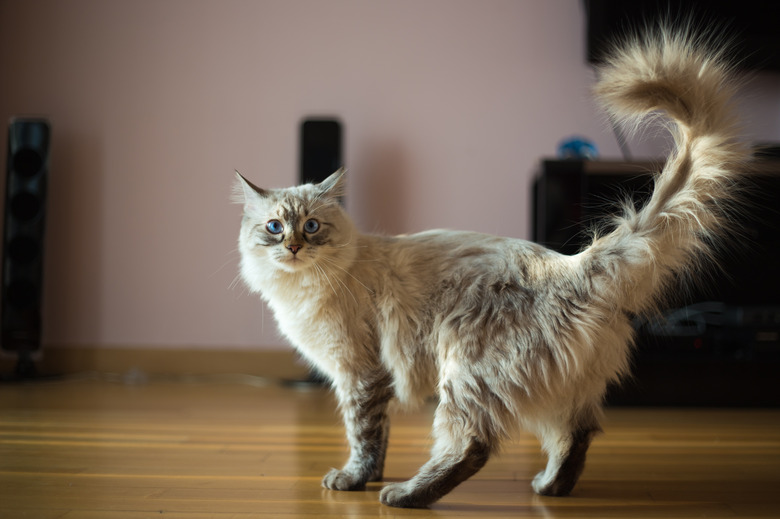Ragdoll Cat Breed Characteristics
Ragdoll cat quick facts
Ragdoll cat quick facts
Length: 17 – 21 inches
Weight: Females: 10 – 15 pounds, males: 15 – 20 pounds
Lifespan: 18 – 20 years
Coat length: Long
Coloring: Blue, chocolate, cinnamon, cream, fawn, lilac, red, or seal color with colorpoint, mitted, or bicolor coat pattern, and blue eyes
Grooming needs: Medium
Friendliness: Breed alone is not an accurate predictor of individual cats' personalities. However, ragdolls are generally regarded as sweet, loving cats.
If you are looking for an affectionate, cuddly cat that you can carry around the house and snuggle with while watching television, the ragdoll breed may be the breed for you. Not only are they great family cats that are tolerant of children. Consider the personality and activity level of the breed before deciding to bring a ragdoll kitten into your family.
These cats also have beautiful longhaired coats that are soft and silky. The ragdoll coat is fairly low maintenance for a longhaired breed. But if you don't want to be bothered with grooming — opt for a shorthair breed instead.
Ragdoll cat history
Ragdoll cat history
The ragdoll cat breed was developed in the 1960s in California by a cat breeder named Ann Baker. Baker believed that her female cat Josephine started the ragdoll breed. Josephine was genetically altered at a medical facility after a car accident — leading to her genes being passed onto the kittens of today.
Josephine and the other cats in the breeding program were free-roaming cats and kittens that displayed the desired appearance and personality traits were used to continue to cultivate the breed.
Ragdoll cats have championship status in both the International Cat Association (TICA) and the Cat Fanciers' Association (CFA). Josephine's genes are credited with starting the ragdoll breed — giving them their unique personality.
Ragdoll cat personality
Ragdoll cat personality
What really sets ragdolls apart is their personality. They are relaxed, laid-back, and affectionate. One of the most important and recognizable of the breed's characteristics is that they live up to their name and go completely limp when you hold them. When you hold and cuddle a ragdoll, they are so relaxed that their body is floppy — just like the rag doll. Ragdoll cats may also resemble other breeds like the Persian, Burmese, and birman cat breeds.
They have also been described as dog-like as they are friendly and intelligent. They make wonderful family cats and they get along with children and other pets. You can even teach your ragdoll cat to play fetch and come when you call them. Unlike many other breeds, ragdoll cats don't tend to climb or jump to the highest points in the room and you may find them resting on the floor or couch instead.
If you are looking for an active and playful cat, the ragdoll cat may not be the best choice as adult cats tend to be less active than some other domestic cat breeds. They also tend to be quiet, so you won't have a cat following you around the home and meowing.
Ragdoll cat lifespan and health issues
Ragdoll cat lifespan and health issues
Well-cared-for and healthy ragdoll cats will generally live into their mid to late teens. The cats are generally very healthy and there are few genetic diseases affecting this cat breed.
One potential health concern is hypertrophic cardiomyopathy (HCM). This is a type of heart disease that causes the walls of the heart chamber to thicken which reduces the amount of blood the heart can effectively pump.
There is a DNA test available for this condition and a reputable breeder of purebred ragdolls will test all of their cats and stop breeding any cat that carries the genes for this disease.
Ragdoll cat grooming and care
Ragdoll cat grooming and care
Ragdoll cats have long, silky coat that needs to be brushed at least once per week. Groom your cat more frequently when they are shedding. Use a stainless steel comb to brush out the tangles. This allows you to comb out the undercoat as well.
If you don't comb out the coat all the way to the skin, there is a risk of matting. If your cat's coat becomes matted, take them to a professional groomer or your veterinarian to have the mats removed. Don't attempt to remove them on your own. It can be quite a painful experience for a cat and you risk damaging the cat's delicate skin.
While not required to maintain a healthy coat, some ragdoll cats enjoy being bathed and having their coat blown dry. You can take your cat to a groomer for bathing. If you opt to do it yourself, make sure to use a shampoo designed for your cat's sensitive skin. Also, make sure the hair dryer isn't too hot.
Feed the cat high-quality cat food as recommended by your veterinarian. Make sure there is fresh drinking water available at all times. Ragdoll cats have a tendency to be extremely laidback but exercise is important to keep your cat healthy and maintain a healthy weight. Play fetch and use cat tip toys, feather wands, and other safe and non-frustrating interactive toys to get your cat up and moving.
Welcoming a new cat into your home
Welcoming a new cat into your home
Bringing a new cat into the family is a fun and exciting experience. Ragdoll cats are laidback and generally adjust well to the new environment. It is still a good idea to make sure the home is set up for your new ragdoll kitten. Cat-proof your home by removing plants or other items that may be harmful to your new cat. Although ragdolls tend to not frequently seek out the high places in the room, it is still a good idea to cat-proof any shelves that they can reach.
Set up all of the supplies your new cat will need. Supplies include:
- food dish
- high-quality kitten or cat food
- water dish
- litter box
- cat tree
- scratching post
- cat toys
Initially, confine your new cat to a single room so that they can safely explore the new environment and get to know you. Don't make the cat hold still to be petted. Instead, wait for them to come to you and always use positive reinforcement. With a bit of patience, this affectionate cat will be snuggling with you before you know it.
This is also a good opportunity to introduce children and any other pets in the household. Once your ragdoll cat is comfortable, you can open the door and give them access to explore. Before you know it, this loving cat will be an integral part of the family.



